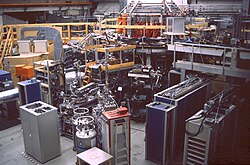 Wendelstein 7-AS in Garching. The stellarator - at the rear right - is almost covered by diagnostic and heating components. | |
| Device type | Stellarator |
|---|---|
| Location | Garching, Germany |
| Affiliation | Max Planck Institute for Plasma Physics |
| Technical specifications | |
| Major radius | 2 m (6 ft 7 in) |
| Minor radius | 0.13–0.18 m (5.1 in – 7.1 in) |
| Plasma volume | approx. 1 m3 |
| Magnetic field | up to 2.6 T (26,000 G) |
| Heating power | 5.3 MW |
| Discharge duration | up to 2 s |
| History | |
| Year(s) of operation | 1988–2002 |
| Succeeded by | Wendelstein 7-X |
Wendelstein 7-AS (abbreviated W7-AS, for "Advanced Stellarator") was an experimental stellarator which was in operation from 1988 to 2002 by the Max Planck Institute for Plasma Physics (IPP) in Garching.[1][2] It was the first of a new class of advanced stellarators with modular coils, designed with the goal of developing a nuclear fusion reactor to generate electricity.
The experiment was succeeded by Wendelstein 7-X, which began construction in Greifswald in 2002, was completed in 2014 and started operation in December 2015. The goal of its successor is to investigate the suitability of components designed for a future fusion reactor.[3]
- ^ Renner, H; Anabitarte, E; Ascasibar, E; Besshou, S; Brakel, R; Burhenn, R; Cattanei, G; Dodhy, A; Dorst, D; Elsner, A; Engelhardt, K (1989). "Initial operation of the Wendelstein 7AS advanced stellarator". Plasma Physics and Controlled Fusion. 31 (10): 1579–1596. Bibcode:1989PPCF...31.1579R. doi:10.1088/0741-3335/31/10/008. ISSN 0741-3335. S2CID 250858130.
- ^ Hirsch, M; Baldzuhn, J; Beidler, C; Brakel, R; Burhenn, R; Dinklage, A; Ehmler, H; Endler, M; Erckmann, V; Feng, Y; Geiger, J (2008). "Major results from the stellarator Wendelstein 7-AS". Plasma Physics and Controlled Fusion. 50 (5): 053001. doi:10.1088/0741-3335/50/5/053001. ISSN 0741-3335. S2CID 118508232.
- ^ Clery, Daniel (2015-10-21). "The bizarre reactor that might save nuclear fusion". Science | AAAS. Retrieved 2020-06-16.